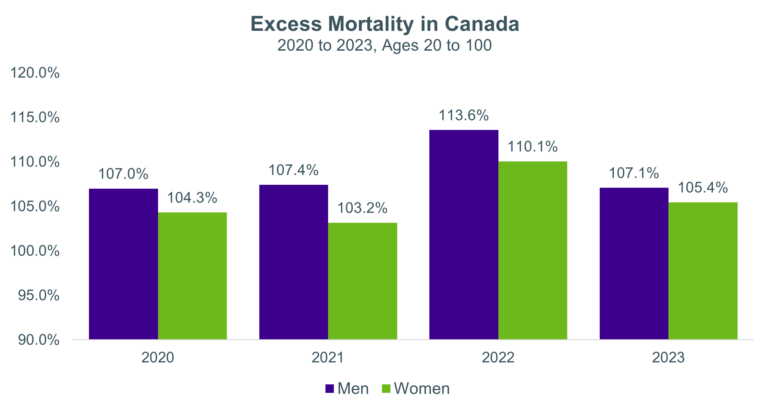Question:
How did excess mortality in Canada progress through 2020-2023?
Answer:
At the general population level, Canada saw elevated mortality through the whole period 2020-2023. 2022 marked a peak in excess mortality, but our calculations show that in 2023 we still experienced more deaths than expected for both men and women – at levels comparable the first year of the pandemic.

We note that any calculation of “excess deaths” relies heavily on the methodology used to calculate the level of expected deaths in a given period. To estimate expected deaths from 2020 to 2023, we used age-specific mortality rates from Statistics Canada's 2017/2019 life tables1. The mortality rates were projected forward using the MI-2017 improvement scale and then applied to annual population exposures2 to calculate expected deaths. We then compared age-standardized3 expected mortality with age-standardized observed mortality for each year. This approach accounts for changes in population size and age structure, ensuring that excess mortality estimates reflect true shifts in mortality patterns. Different methodologies can yield different estimates of excess mortality, depending on assumptions about mortality trends as well as the reference period and data used.
Key takeaways
- At the general population level, Canada’s recovery from the pandemic has been slower than other countries, with excess mortality in 2023 remaining elevated – similar to levels seen in 2020.
- The drivers of excess mortality in 2023 may be shifting, with COVID-19 playing a smaller role and other factors - such as delayed healthcare, chronic conditions, deaths from other causes, and other indirect effects playing a greater role.
- The figures presented are for the overall Canadian population. There are variations in excess death levels between insured populations and the general population and also between different regions across Canada, with western Canada (BC, AB, SK) experiencing even higher levels of excess compared to the overall population.
- Provisional data for 2024 suggests excess mortality has not disappeared, however it appears to be lower than in 2023.
The key questions are:
- What are the primary causes of excess mortality in 2023? Are they still pandemic-related, or are new patterns emerging?
- Will mortality rates return to pre-pandemic expectations? Or are we seeing the formation of a “new normal”?
- How should pension plans and insurers adjust their longevity assumptions considering continued excess mortality?
1. Statistics Canada. Table 13-10-0114-01 Life expectancy and other elements of the complete life table, three-year estimates, Canada, all provinces except Prince Edward Island
2. Human Mortality Database (HMD). Max Planck Institute for Demographic Research (Germany), University of California, Berkeley (USA), and French Institute for Demographic Studies (France). Available at www.mortality.org (data downloaded on September 10, 2025)
3. Age standardization completed using the 2021 Canadian census population structure.




